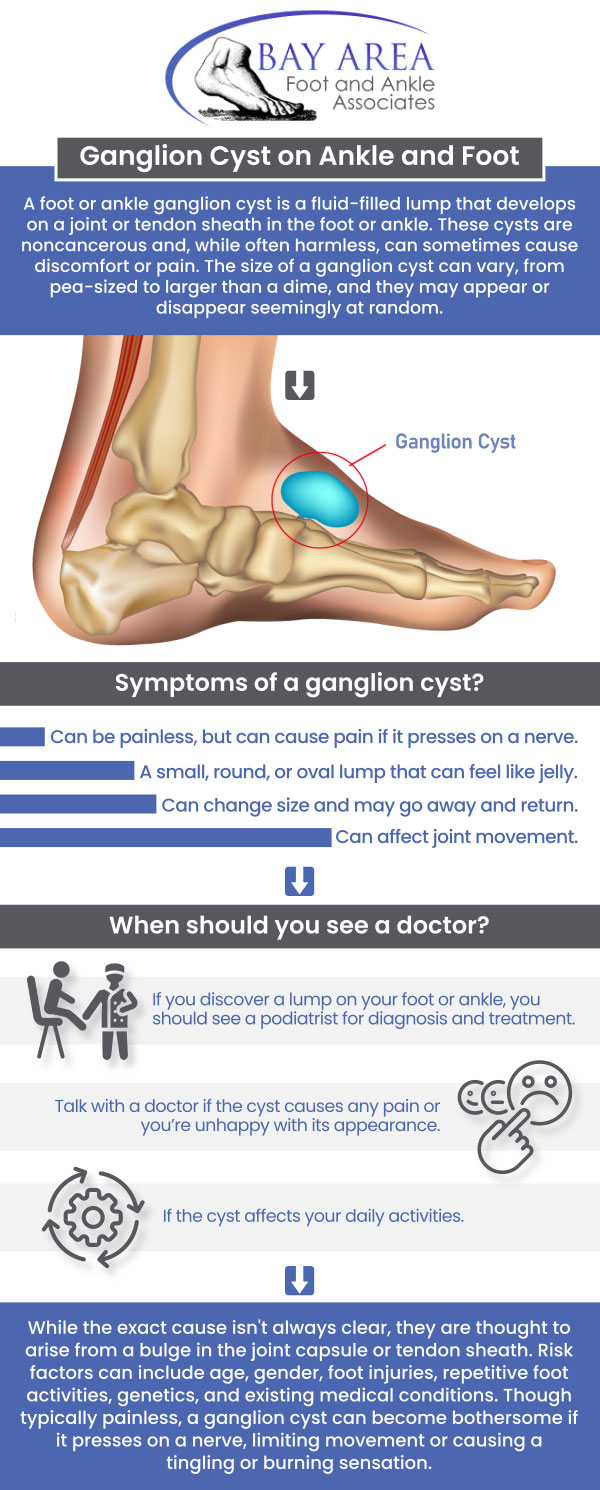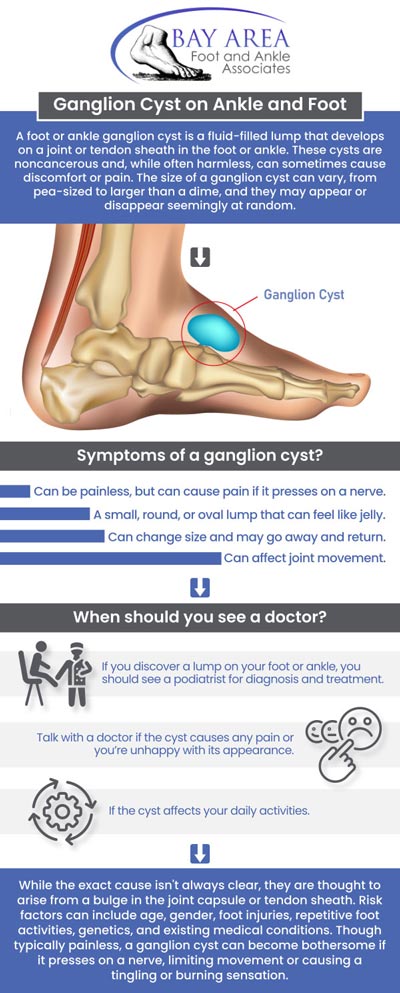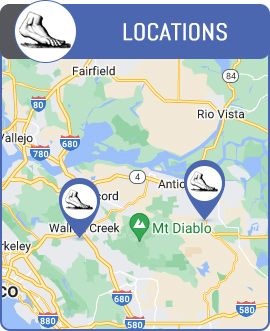Foot Ganglion Cyst Treatment Specialist Q&A
Ganglion cysts are masses that typically occur in ankle and foot tendons or joints. Ganglion cysts are often round or oval in shape, and they contain a jellylike fluid. They’re not cancerous tumors. Ganglion cyst symptoms may include an apparent lump, tingling or burning, dull discomfort, or trouble wearing shoes. If you find a lump or pain in your ankle or foot, visit Dr. John W. Scivally, DPM, and Robin K. Lie, DPM at Bay Area Foot and Ankle Associates. For more information, contact us or schedule an appointment online. We have convenient locations to serve you in Walnut Creek, CA, and Brentwood, CA.




Table of Contents:
What is a ganglion cyst foot?
What causes ganglions on feet?
What are the symptoms of ganglion cyst feet?
How can a podiatrist help with ganglion cyst foot?
Ganglion cysts are non-cancerous lumps that are filled with fluid and typically develop near tendons or joints. Although they are generally harmless, medical intervention may be required to get rid of a ganglion cyst.
Ganglion cysts can develop on joints or tendons and most frequently form on the ankle or the top of the foot but they can develop in various areas of the foot including the bottom or between the toes. They can also sometimes develop on the wrists, hands, fingers, and ankles, and even less frequently but still on the shoulders, knees, and spine. They are fluid-filled sacs that develop as round bumps that are typically harmless and can be either firm or soft to the touch. Ganglion cysts are typically pretty small but can range a bit in size, from about the size of a pea to more than 1 inch in diameter. Even though they are typically harmless, they can cause some discomfort or limited movements if they develop near nerves or tendons, applying pressure with movement.
Ganglion cysts form when there is a leakage of fluid from joints or tendons that are nearby, leading to the formation of the round cyst, but we do not yet know why there is a leakage of fluids in the first place. Some possible contributing factors that may increase the chance of developing ganglion cysts on the feet include incurring repetitive stress or trauma to the affected area, irritation to the tendon or joint, or a different underlying health condition, such as osteoarthritis or rheumatoid arthritis. They can also develop without any known underlying cause, making them difficult to prevent. The only way to reduce the risk of their formation is to practice proper foot care by wearing shoes that provide sufficient support to prevent unnecessary stress on the foot and to manage any underlying joint conditions, if applicable. If you tend to develop ganglion cysts, it is a good idea to consult with a qualified healthcare provider to determine if there is anything that you can do to prevent them from forming again in the future.
There are several common symptoms of a ganglion cyst on the foot, with the most common symptom being the visible bump or lump that develops. This bump can form in a variety of places around the foot where there is a joint or a tendon, but most frequently occurs on the top or the side. There is also some variance with the structure of the ganglion cyst, with it ranging from being soft and spongy to firm to the touch. The cyst itself is unlikely to cause any pain, but it is common to experience discomfort when walking or wearing shoes that apply pressure to the ganglion cyst, and depending on the location, the cyst may impede joint movement. Ganglion cysts may go away on their own, but there is no guarantee that they will go away without treatment, and they may even continue to grow without any medical intervention. If the ganglion cyst is causing you any discomfort or you just simply wish to get rid of it, you will likely need to receive proper care from a qualified healthcare provider.
Podiatrists are physicians who have specialized in feet, making them one of the most qualified medical professionals to help treat ganglion cysts that develop on the foot. They will be the most qualified to evaluate the cyst, providing an accurate diagnosis and providing patients with a variety of treatment options depending on what is most likely to be safe and effective for each case. Different treatment options may include draining the fluid from the cyst, injecting corticosteroids into the cyst, or surgically removing the cyst. In cases where the cyst is very small and not yet interfering with the patient’s comfort, another treatment option will be to just keep an eye on the cyst to see if it grows or can just go away on its own without intervening. A podiatrist will be able to work with you to determine the best course of treatment for your situation and will be there to guide you through the process.
Ganglion cysts are not cancerous and rarely harmful, however, they can cause pain. If you have ganglion cysts and are looking for treatment, come to Bay Area Foot and Ankle Associates. For more information, contact us or schedule an appointment online. We have convenient locations to serve you in Walnut Creek, CA, and Brentwood, CA. We serve patients from Walnut Creek CA, Brentwood CA, Concord CA, Pleasant Hill CA, Pittsburg CA, Antioch CA, Alamo CA, Danville CA, Oakley CA, and surrounding areas.

Additional Services You May Need
▸Custom Foot Orthotics
▸Ingrown Toenail Specialist
▸Traditional Podiatry Care
▸Foot and Ankle Surgery Clinic
▸Bunion Doctor
▸Corns and Calluses
▸Foot Arthritis and Joint
▸Warts
▸Video Gait Analysis
▸Athletic Taping
▸Pediatric Foot Specialist
▸Gait Abnormalities
▸Foot Dermatologist
▸Foot Deformities
▸Chronic Foot Injury
▸Diabetic Foot Specialist
▸Acute Foot Injuries
▸Podiatric Sports Services
▸Plantar Fasciitis Specialists


